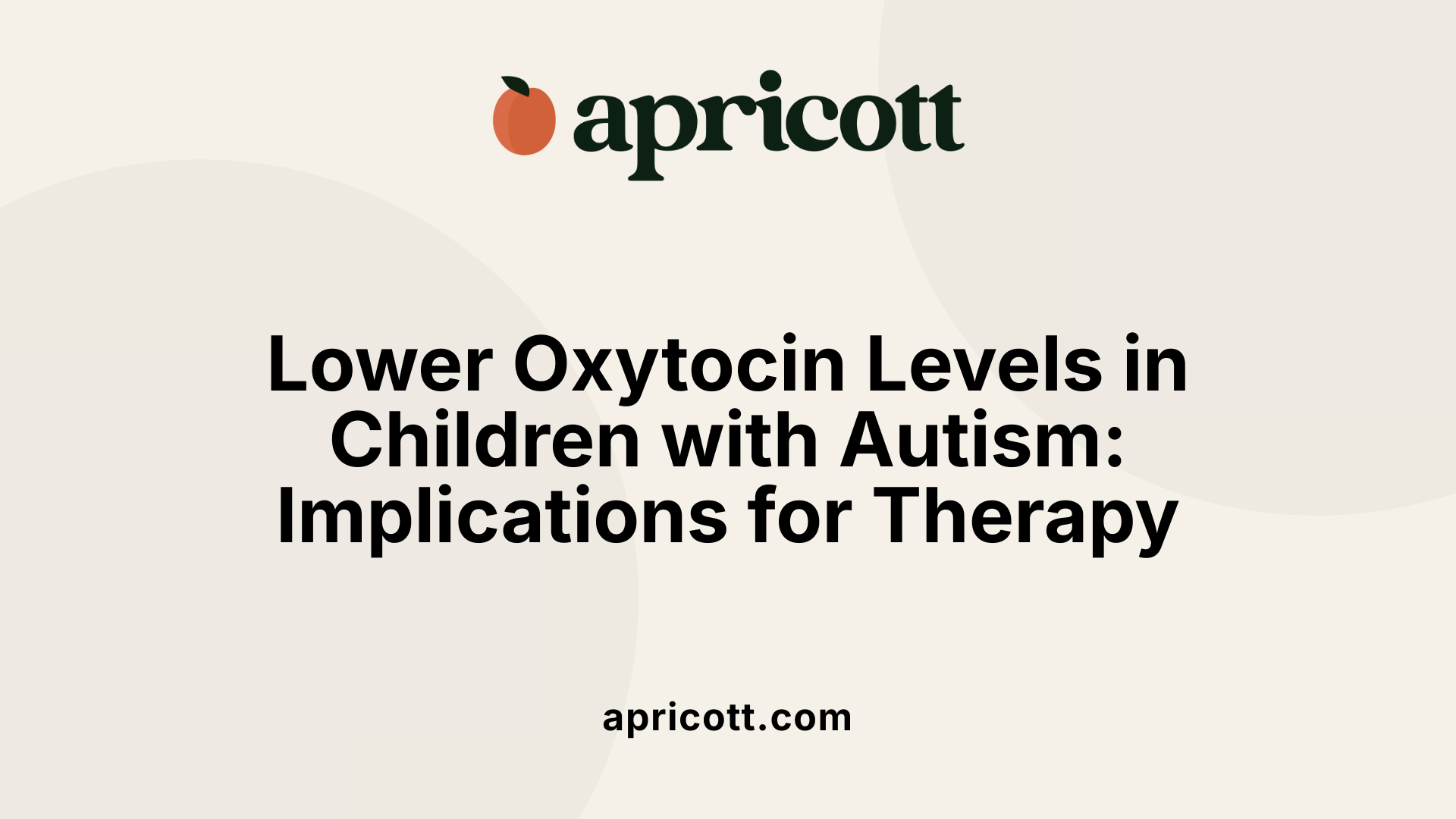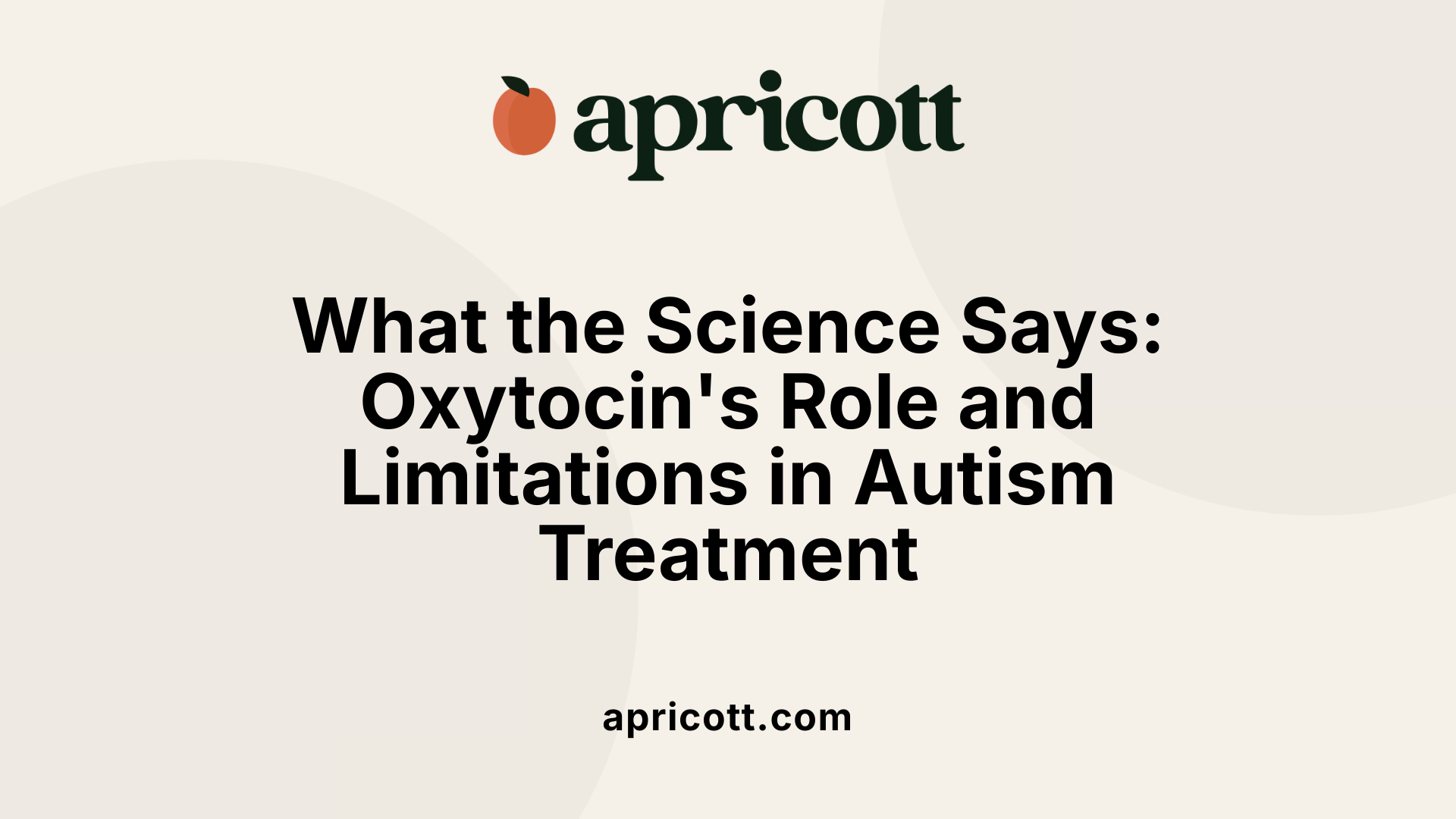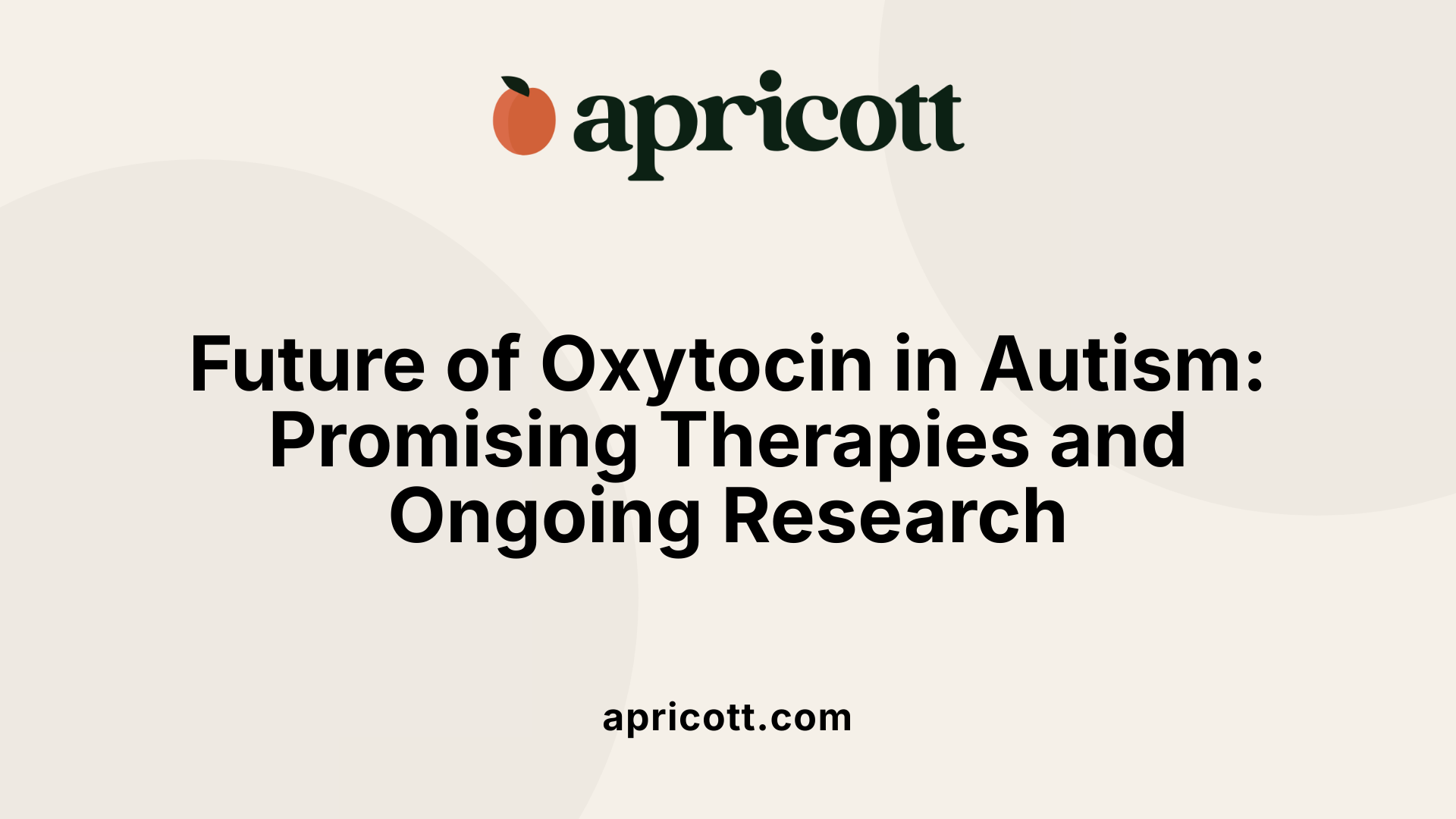August 6, 2025
Exploring the Connection Between Oxytocin and Autism Spectrum Disorder
Autism Spectrum Disorder (ASD) is characterized by social communication challenges and repetitive behaviors, with emerging research suggesting that the neuropeptide oxytocin plays a significant role. Known as the 'bonding hormone,' oxytocin influences social motivation, trust, and emotional recognition. This article delves into the biological mechanisms linking oxytocin to autism, reviews scientific studies on its potential as a therapeutic target, and discusses ongoing research efforts aimed at understanding and harnessing this connection.
The causes of autism spectrum disorder (ASD) are complex, involving a mixture of genetic and environmental factors. Research indicates that genetics play a vital role, with twin studies showing that 60-90% of autism risk might be inherited. Variations and mutations in multiple genes, including those related to brain development and communication, have been linked to increased likelihood of ASD.
Environmental influences also contribute significantly. Factors such as advanced parental age at conception, exposure to air pollution or pesticides during pregnancy, and maternal health issues like obesity, diabetes, or immune system disorders are associated with higher autism risk. Additionally, birth-related complications, including prematurity, low birth weight, or oxygen deprivation during delivery, can increase susceptibility.
An important aspect of current understanding is how gene-environment interactions influence autism development. For example, certain genetic traits may make individuals more vulnerable to environmental exposures, thereby elevating their risk of ASD.
It is crucial to clarify that scientific consensus firmly states vaccines do not cause autism. These misconceptions have been thoroughly debunked by extensive research.
Genetic factors also influence the oxytocin system, which is involved in social bonding and behaviors. Variations in genes such as the oxytocin receptor gene (OXTR) have been associated with autism, potentially impacting receptor expression or functioning. Some individuals with autism exhibit mutations or polymorphisms in these genes that might reduce oxytocin signaling, contributing to social impairments.
Environmental influences can affect oxytocin levels and receptor functioning. Factors that interfere with typical hormone production or receptor expression during critical developmental periods may alter social motivation and attachment behaviors.
Understanding how genetic predispositions interact with environmental exposures is essential for developing targeted interventions. For instance, children with certain genetic markers might benefit from early environmental modifications or therapeutic approaches aimed at enhancing oxytocin pathways.
Overall, the scientific community recognizes autism as a neurodevelopmental disorder with a multifactorial etiology. No single cause explains all cases, but rather a blend of inherited genetic factors and prenatal, perinatal, and postnatal environmental influences. This nuanced understanding guides ongoing research to uncover more about how these factors interplay and to develop effective treatments.
 Research shows that children with autism often have lower levels of oxytocin in their blood compared to neurotypical children. This difference is especially notable in the developmental years, suggesting that the oxytocin system may play a role in the challenges faced by children with ASD, particularly in social bonding and interaction.
Research shows that children with autism often have lower levels of oxytocin in their blood compared to neurotypical children. This difference is especially notable in the developmental years, suggesting that the oxytocin system may play a role in the challenges faced by children with ASD, particularly in social bonding and interaction.
A meta-analysis of 31 studies supports this, indicating that lower oxytocin levels are predominantly observed in children rather than adults with autism. This points to a possibility that oxytocin's influence on social behavior is more significant during early development. The reduced levels are linked to more severe social impairments, emphasizing the hormone's potential importance in early social and emotional development.
Despite these findings, studies involving adults with autism generally do not find substantial differences in oxytocin levels compared to neurotypical adults. This could indicate that oxytocin levels vary over the lifespan or that other factors influence social behaviors in adulthood.
The association between low oxytocin levels and autism severity suggests that oxytocin could serve as a biological marker for identifying social deficits early in life. Furthermore, some experimental treatments show promise; for example, administration of intranasal oxytocin can temporarily elevate blood oxytocin levels and may improve social recognition and trust, especially in children with initially low levels.
Understanding these differences in oxytocin dynamics opens pathways for targeted interventions during critical developmental periods. Interventions aimed at modifying oxytocin levels might help in alleviating some social challenges associated with autism, though more research is necessary to determine effective treatments and timing.
In summary, children with autism tend to have lower oxytocin levels compared to their neurotypical peers. These differences could influence social development and might offer avenues for early diagnosis and intervention, although the exact nature of oxytocin's role continues to be explored.
 Research into the effects of oxytocin on autism symptoms has produced a complex and varied picture. Numerous studies, including meta-analyses, have shown that children with autism spectrum disorder (ASD) tend to have lower levels of oxytocin, a hormone involved in social bonding and emotional recognition, compared to their neurotypical peers. For instance, a meta-analysis of 31 studies concluded that the blood oxytocin levels in children with ASD are generally lower, especially in children rather than adults. This suggests a potential biological link between oxytocin and social challenges characteristic of autism.
Research into the effects of oxytocin on autism symptoms has produced a complex and varied picture. Numerous studies, including meta-analyses, have shown that children with autism spectrum disorder (ASD) tend to have lower levels of oxytocin, a hormone involved in social bonding and emotional recognition, compared to their neurotypical peers. For instance, a meta-analysis of 31 studies concluded that the blood oxytocin levels in children with ASD are generally lower, especially in children rather than adults. This suggests a potential biological link between oxytocin and social challenges characteristic of autism.
However, the effects of administering oxytocin to improve autism symptoms are mixed. Some smaller studies, like a Stanford University trial involving 32 children, found that intranasal oxytocin temporarily enhanced social behaviors such as eye contact and emotional recognition. These children's baseline oxytocin levels appeared to predict better responses to treatment. In addition, animal studies support this biological connection, showing that oxytocin influences social recognition and bonding, with deficits in the oxytocin system leading to social impairments.
In contrast, large-scale clinical trials, especially those published in reputable sources like the New England Journal of Medicine, have not demonstrated significant benefits. A prominent trial involving children and adolescents aged 3 to 17 found that twice-daily intranasal oxytocin did not result in meaningful improvements in social or cognitive functioning after four weeks of treatment. Similarly, a broader systematic review indicates that most short-term studies have failed to show consistent positive effects on core autism symptoms, such as repetitive behaviors or anxiety levels.
This divergence in findings can be attributed to various factors. Differences in participants' age, baseline oxytocin levels, genetic variations—such as in the oxytocin receptor gene (OXTR)—treatment dosage, and duration all influence outcomes. Moreover, while some biological measures, like increased salivary oxytocin levels and decreased methylation of the OXTR gene, have been observed following treatment, these changes do not always translate into clinical improvements.
In summary, current evidence suggests that although low oxytocin levels are associated with autism and biological mechanisms show potential, the therapeutic use of oxytocin remains unproven. The scientific community continues to investigate whether targeted, personalized approaches could harness oxytocin’s effects more effectively in the future. For now, oxytocin therapy is not recommended as a standard treatment for autism, and more research is necessary to understand its role and optimize any potential benefits.

Research into oxytocin-based treatments for autism spectrum disorder (ASD) highlights intranasal oxytocin administration as a promising approach to enhance social functioning. Multiple studies suggest that children with lower baseline levels of oxytocin tend to benefit more significantly from this therapy. For example, chronic intranasal administration of oxytocin has been shown to increase endogenous oxytocin levels in saliva, indicating a biological effect.
Furthermore, some research points to epigenetic modifications related to oxytocin. After several weeks of treatment, decreases in methylation of the oxytocin receptor gene (OXTR) have been observed, which could lead to increased receptor availability and improved social engagement.
However, the effects are specific: while improvements in social behavior and attachment have been documented, effects on repetitive behaviors or anxiety levels remain unclear. Despite these promising signs, more rigorous, large-scale clinical trials are needed to establish effective protocols and identify which children are most likely to respond. Overall, the current evidence suggests the potential for oxytocin therapy to positively influence social motivation in certain subgroups of children with ASD.
Yes, the landscape of autism treatment involving oxytocin is actively evolving. Recent research continues to explore the biological impact of oxytocin therapy, notably its capacity to modify oxytocin receptor gene methylation and elevate salivary oxytocin levels. Such biological changes support the idea that exogenous oxytocin can stimulate the body's natural social systems.
In clinical settings, studies have reported that children with autism who start with low oxytocin levels show more noticeable improvements in social behaviors after treatment. These findings point towards a personalized approach, where baseline oxytocin measures might guide therapeutic decisions.
Large trials, including one in the Proceedings of the National Academy of Sciences, continue to test the safety and efficacy of chronic intranasal oxytocin. As ongoing research aims to refine dosing strategies and identify responder profiles, the prospect of more targeted and effective oxytocin-based therapies becomes increasingly feasible.

Currently, oxytocin is not an approved or standard treatment for autism. Although some studies have explored its potential to improve social behaviors, the results have been mixed and often inconclusive. The largest and most recent clinical trial involving 290 children found no significant benefits in social functioning after intranasal oxytocin treatment.
A smaller study suggested that children with lower baseline blood oxytocin levels might experience some social improvements, indicating a potential for personalized approaches, but these findings require further validation.
Overall, current evidence does not support the routine use of oxytocin for autism, and ongoing research is needed to determine its efficacy and safety for this purpose.
Administering oxytocin carries certain risks and ethical issues. While generally considered safe in controlled settings, possible side effects include nasal irritation, headaches, or undesired hormonal effects. Ethical concerns also arise regarding consent, especially in pediatric populations, and the long-term impacts are not well understood.
Doctors and caregivers must evaluate whether potential benefits outweigh the risks, especially since current data do not reliably demonstrate treatment benefits.
Most studies to date have been short-term and focused on adults or small groups of children. They often lack the statistical power needed for definitive conclusions. Additionally, variability in dosage, treatment duration, and measures of social improvement complicate outcome comparisons.
Many studies also fail to consider genetic differences among participants, which could influence responsiveness to oxytocin therapy. Consequently, the evidence remains insufficient to establish standardized protocols.
While generally tolerable, oxytocin administration may cause side effects such as nasal discomfort, headaches, or changes in blood pressure. Reproductive hormonal effects have been observed in certain contexts but are rarely problematic in short-term therapeutic settings.
Long-term safety data are limited, raising concerns about potential hormonal or developmental impacts, especially in children whose brains are still developing.
Emerging research suggests that oxytocin’s effects vary significantly across individuals, possibly due to genetic differences in oxytocin receptor genes (OXTR) or baseline oxytocin levels.
Personalized treatment approaches, potentially guided by genetic testing, could help identify which subgroups of autistic individuals might benefit from oxytocin therapy. Future studies should incorporate these factors to optimize safety and effectiveness, moving toward more tailored interventions rather than a one-size-fits-all approach.
While the connection between oxytocin and autism offers promising insights into the biological underpinnings of social deficits, current clinical evidence underscores the complexity of translating this knowledge into effective treatments. The variability in oxytocin levels among children with autism, combined with mixed research results, highlights the need for personalized approaches and further exploration of genetic and epigenetic factors. Ongoing large-scale trials aim to clarify whether certain subgroups could benefit from oxytocin therapies, possibly when combined with behavioral interventions. Advances in understanding the biological mechanisms, such as receptor gene methylation and endogenous oxytocin regulation, hold potential for future targeted therapies. Despite the challenges, the scientific community remains optimistic about the role of oxytocin in understanding and possibly ameliorating some aspects of autism in the future.